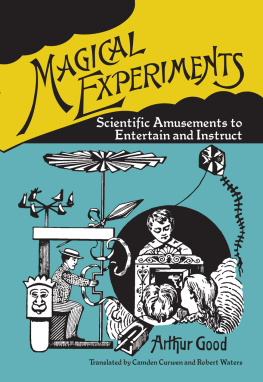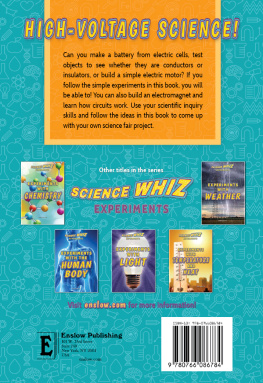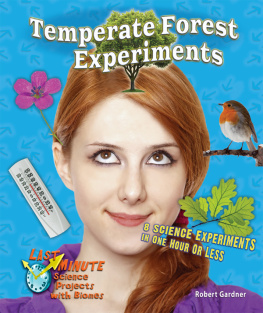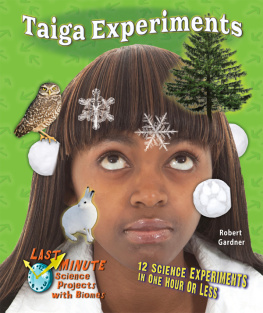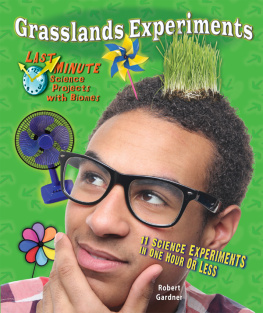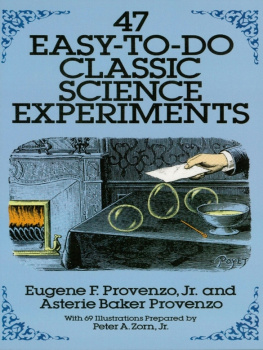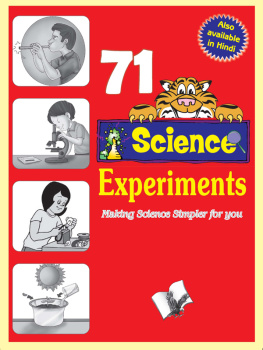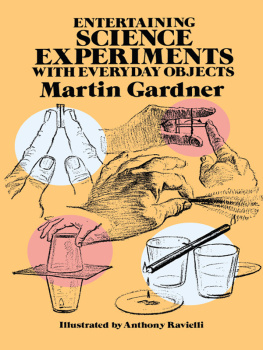


Bibliographical Note
This Dover edition, first published in 2019, is an unabridged republication of the work originally published as Magical Experiments, or Science in Play by David McKay, Publisher, Philadelphia, in 1894. Please note that the experiments in this book should be undertaken with adult supervision and the materials and apparatus should be used only as instructed. The publisher is not responsible for the safety of those performing the activities in this book and accepts no liability for any damage or injury that may arise in connection with the publication of this title.
Library of Congress Cataloging-in-Publication Data
Names: Tit, Tom, author.
Title: Magical experiments: scientific amusements to entertain and instruct / Arthur Good ; translated by Camden Curwen and Robert Waters.
Other titles: Science amusante. English
Description: Mineola, New York : Dover Publications, 2019.
Identifiers: LCCN 2019002598 | ISBN 9780486834207 (paperback) | ISBN 0486834204
Subjects: LCSH: Scientific recreations. | Magic tricks. | BISAC: SCIENCE / Experiments & Projects. | SCIENCE / General. | GAMES / Magic.
Classification: LCC GV1547 .G64 2019 | DDC 793.8dc23
LC record available at https://lccn.loc.gov/2019002598
Manufactured in the United States by LSC Communications
83420401 2019
www.doverpublications.com
TO MY SON JOHNNIE.
My dear little boy :
Among the experiments contained in this book, many are simple pastimes meant for the recreation of young and old, assembled round the family table.
Others, on the contrary, being of a really scientific character, are designed to introduce the reader to the study of Physics, that marvellous science to which we owe the discovery of the steam-engine, the telephone, the phonograph, and many other wondersa science which, there can be little doubt, holds in reserve many other miracles for man.
The whole of these experiments, whether simple or complex, may be performed without any special apparatus whatever, consequently without the least expense. Our improvised laboratory is composed, as you will perceive, of such articles as kitchen utensils, corks, matches, glasses, knives, forks, and platesin fact, such things as every house, the humblest in the land, possesses.
In dedicating this book to you, I trust it may prove a pleasant souvenir, in the days to come, of the happy moments we passed together in working these simple wonders, and in constructing the homely apparatus used in our MAGICAL EXPERIMENTS.
Your affectionate father,
ARTHUR GOOD ("TOM TIT").
Paris, 1st of January, 1890.
PREFACE.
To the young person who wishes to make himself agreeable and entertaining in company, this book will be one of the most helpful in literature. It will show him not only how to do things by which he can render himself more entertaining than the best talker or the best joker in the company, but will reveal to him a hundred things by which he can amuse and astonish everybody he knows. For the experiments here displayed are not only entertaining, but instructive ; not only amusing, but surprising ; not only attractive to the young man and the maiden, but to the old man and the matron. By means of the simplest and commonest objects, always at hand, the reader can illustrate some of the most wonderful things in science, and convey valuable instruction while amusing his audience and creating a feeling of admiration for the amusement-maker.
To the teacher who wishes to create in his scholars an interest in science, no book can be of greater assistance. It will enable him practically to illustrate and enforce scientific principles, and render his instructions as interesting as an Arabian tale.
My share of the book consists in the translation of the latter half, and the revision and correction of the whole. The late Mr. Camden Curwen, at the time of his death, left the work but half finished, when it was placed in my hands. Mr. Curwen has done his part of the work well, and my hope is that the critics will not consider mine much inferior.
As to the author, Mr. Arthur Good, his work speaks for itself. Not only his skill and ability, but the genial and kindly nature of the man, crop out at every page.
ROBERT WATERS.
17 TROY STREET,
JERSEY CITY HEIGHTS, N. J.
MAGICAL EXPERIMENTS;
OR,
SCIENCE IN PLAT.

EXPERIMENTS IN PHYSICS.

The Plate on the Point of the Needle.
EVERYBODY has seen the jugglers in the circus spinning plates, and even dishes, on a pointed stick. For the most part, the plates they use are made of wood or metal, and their equilibrium is due to centrifugal force, which will fail just as soon as the rotation is too weak to overcome the force of gravity.
But here is a way to balance a china plate on the point of a needle, and even to cause it steadily to spin upon this delicate support.
Cut a couple of corks down the middle, through the long axes, and in the extremity of the four halves thus obtained insert as many forks, inclined to the smooth sides of the corks you have just cut at a little less than a right angle. Place these four corks, as in the illustration, round the rim of the platter, at equal distances from one another, and see that the teeth of the forks are in contact with the rim, to prevent them swaying like so many pendulums.
The little system we have now constructed is capable of being balanced, even firmly so to speak, upon the point of a needle, whose eye-end is buried in the cork of an upright wine-bottle. With a little care to prevent the plate slipping, you may even cause it safely to rotate at a fair rate of speed, which, when once set in motion, will continue for a long while, because the friction at the point of contact is almost nil.

The Egg that will Stand up.
Fix two forks firmly in a cork, as in the illustration, observing that they are of equal weight and at equal angles with the perpendicular ; gently hollow out the lower portion of the cork with a sharp penknife, so that it may fit with some exactness one of the ends of the egg. Now poise the other end of the egg carefully on the edge of the neck of the bottle ; see that the egg is in the vertical position, and after a few tentative shakes, not letting go of it at once, you can ascertain that the whole is in a state of equilibrium, an effect that is obtained, of course, by our thus placing the centre of gravity below the point of support.

Next page
